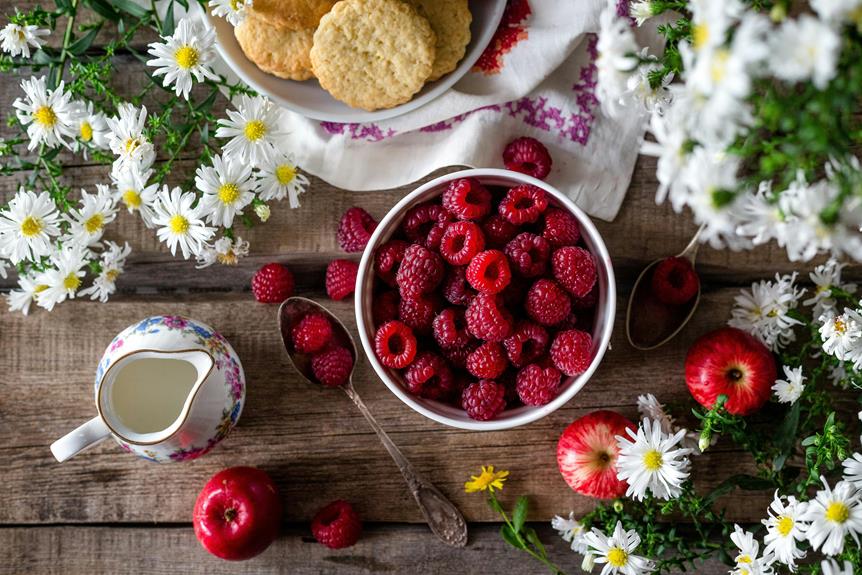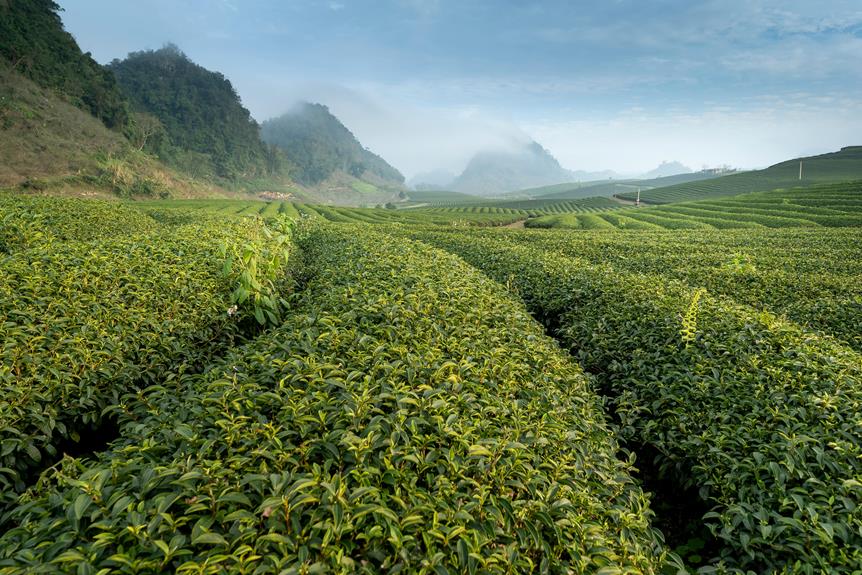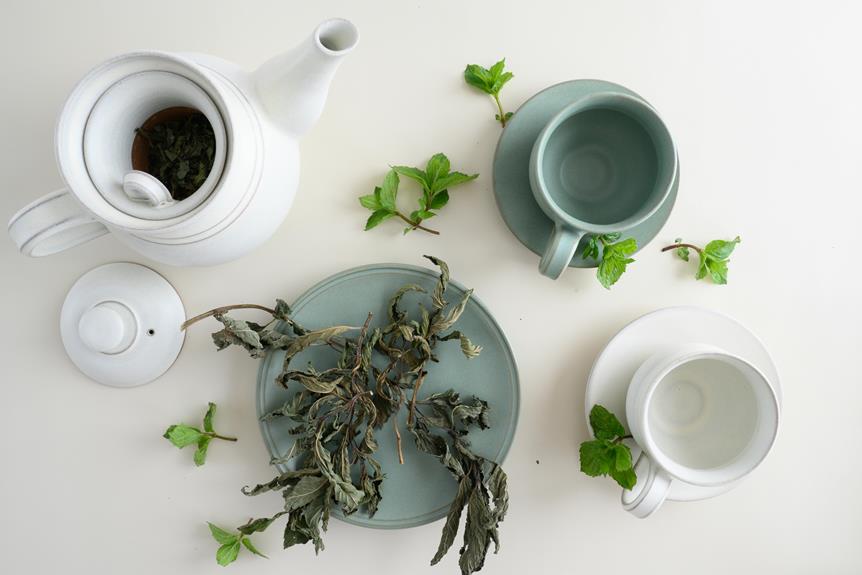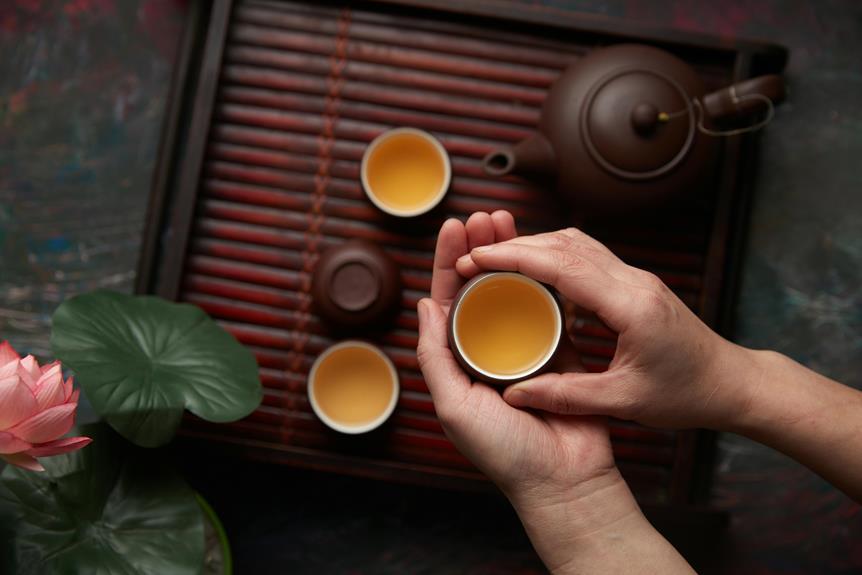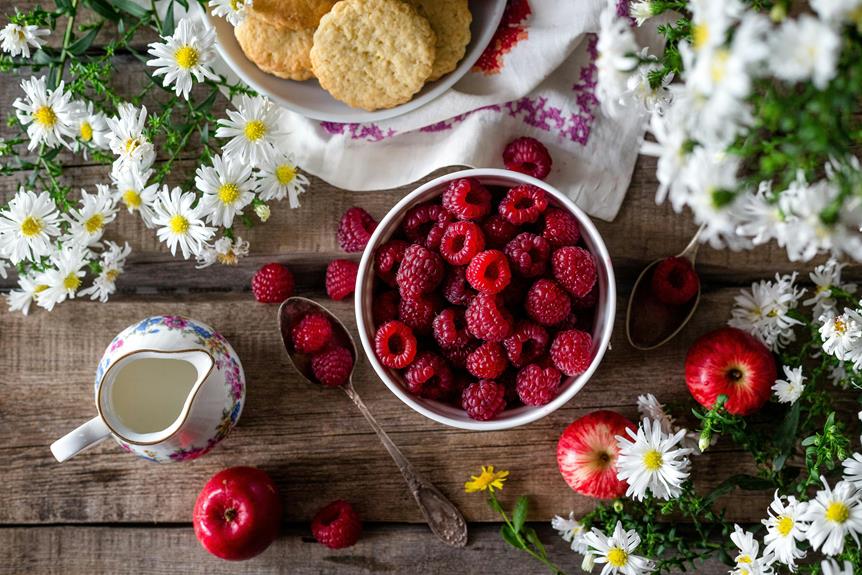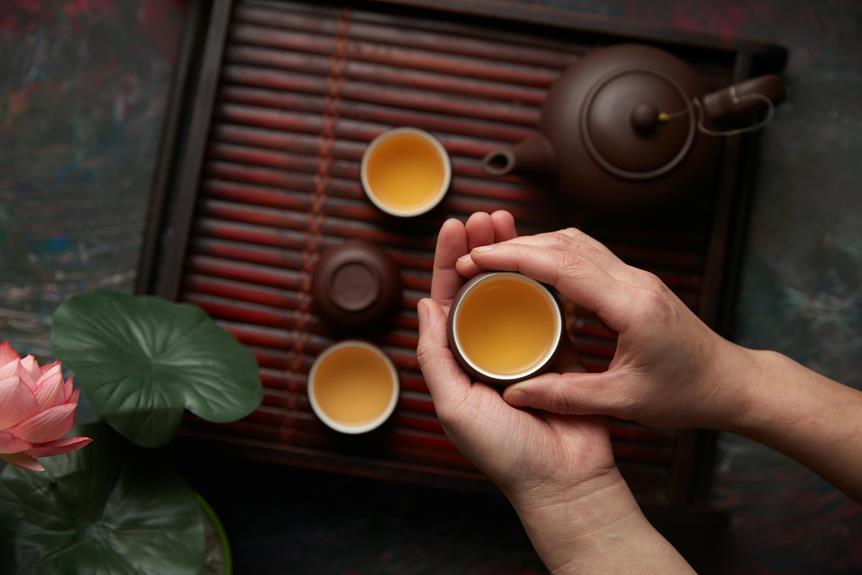As you explore the world of specialty teas, you'll realize that unique processing techniques are behind each distinct flavor profile and aroma. From Taiwanese oolong's high-altitude, misty climate to Japanese Gyokuro's meticulous rolling, every step matters. Indian Assam's terroir, Chinese Pu-erh's fermentation, and Kenyan Purple Tea's anthocyanin retention all contribute to their characteristic tastes. White tea requires gentle handling, yellow tea precise oxidation control, and Korean green tea precise steaming. These techniques are just the beginning – as you continue, you'll uncover even more intricate processes that shape the world of specialty teas.
Key Takeaways
- Taiwanese oolong teas' unique flavor profiles are shaped by high-altitude, cool, misty climates that slow down leaf growth and enhance flavor development.
- Gyokuro's distinctive flavor and aroma are attributed to meticulous rolling techniques that release enzymes and unfurl leaves evenly, revealing complex flavors and aromas.
- Pu-erh tea's unique fermentation process, involving microbial fermentation, breaks down cellular structure and releases unique compounds, setting it apart from other teas.
- Yellow tea requires precise control over oxidation temperature and timing to bring out its unique flavor profile, with ideal temperatures ranging from 20°C to 25°C.
- Korean green tea's steaming process is critical, with ideal steaming times of 30 seconds to 1 minute, to inactivate enzymes responsible for oxidation and preserve flavor and aroma.
The Art of Taiwanese Oolong
Taiwanese oolong teas occupy a unique space in the world of specialty teas, prized for their complex flavor profiles and delicate aromas.
This is largely due to the island's distinct Taiwanese terroir, which imparts a unique character to the teas.
As you explore the world of Taiwanese oolong, you'll discover that the nuances of this tea type are deeply rooted in the region's geography and climate.
The teas are often grown in high-altitude regions, where the cool, misty climate slows down the growth of the leaves, allowing for a more complex flavor development.
When you brew a Taiwanese oolong, you'll notice the subtle interplay of floral, fruity, and nutty notes, which are expertly coaxed out through a series of rolling, oxidizing, and firing processes.
The art of Taiwanese oolong is all about balancing these nuances to create a harmonious and revitalizing cup.
As you venture into this world, you'll find that each tea has its own distinct personality, shaped by the terroir and the skillful hands of the tea makers.
Japanese Gyokuro Rolling Techniques
One of Japan's most prized green teas, Gyokuro, owes its distinctive flavor and aroma to the meticulous rolling techniques employed by skilled artisans.
As you explore the world of Gyokuro, you'll discover a rich history that dates back to the 19th century. The unique processing methods used to create Gyokuro are rooted in tradition and require great skill.
During the rolling process, artisans carefully manipulate the leaves to release the enzymes that give Gyokuro its signature umami flavor.
This labor-intensive process involves gentle rolling, kneading, and shaping of the leaves to achieve the perfect balance of flavors.
The rolling technique is vital, as it allows the tea leaves to unfurl evenly, releasing the complex flavors and aromas.
As you experience Gyokuro, you'll appreciate the attention to detail and craftsmanship that goes into creating this exceptional tea.
With each sip, you'll be transported to Japan's lush tea gardens, where the art of leaf manipulation meets tradition and innovation.
Indian Assam Tea Production
As you shift your focus from Japan's meticulous Gyokuro rolling techniques to the heart of India's tea country, Assam's lush tea gardens await, where the strong, malty flavors of their iconic black tea are born.
The region's unique terroir, characterized by the Assam climate's high temperatures and heavy rainfall, sets the stage for tea production. The Brahmaputra rivers, which flow through the valley, provide a constant supply of fresh water, further enriching the soil.
Tea leaves are plucked from the bushes and withered to remove excess moisture. Next, they're rolled to release the enzymes that trigger oxidation, giving Assam tea its distinct flavor profile.
The oxidation process is carefully controlled to achieve the perfect balance of strength and flavor. Finally, the tea is fired in hot ovens to stop the oxidation process, resulting in the characteristic strong, malty flavor that Assam tea is famous for.
As you explore the world of specialty teas, you'll find that Assam's unique combination of climate, soil, and processing techniques sets it apart from other tea-producing regions.
Chinese Pu-erh Fermentation Methods
In southwestern China's Yunnan Province, Pu-erh tea undergoes a unique fermentation process that sets it apart from other types of tea.
As you explore the world of Pu-erh, you'll discover that the region's distinct terroir plays a significant role in shaping the tea's flavor profile. The Pu erh Terroir, characterized by high altitudes, rich soil, and a subtropical climate, contributes to the tea's earthy and mellow notes.
The fermentation process itself is a complex and time-consuming affair.
You'll notice that the Fermentation Timeline for Pu-erh can span several years, with some teas undergoing multiple rounds of fermentation. This slow and natural process involves allowing the tea leaves to undergo microbial fermentation, which breaks down the cellular structure and releases the tea's unique compounds.
As the tea ferments, it develops a rich, earthy flavor that's both mellow and complex. With each passing year, the tea's flavor profile evolves, becoming smoother and more refined.
Whether you're a seasoned tea enthusiast or just starting your journey, Pu-erh's unique fermentation methods are sure to captivate your senses.
Kenyan Purple Tea Processing
Kenyan Purple Tea, a relatively new and rare variety, employs a unique processing method that sets it apart from other teas.
This processing method involves a combination of traditional and modern techniques to bring out the tea's distinct characteristics. The purple leaves of the tea plants are carefully hand-picked and then subjected to a process called 'anthocyanin retention,' which helps to preserve the tea's natural antioxidants and flavor compounds.
The tea plants used for Kenyan Purple Tea are specially cultivated tea clones that have been bred to produce the distinctive purple leaves. These clones are grown in specific regions of Kenya that provide the ideal climate and soil conditions for the tea plants to thrive.
The processing method used for Kenyan Purple Tea is designed to enhance the tea's natural sweetness and fruity flavors, while also preserving its delicate aroma. As you explore the world of specialty teas, you'll discover that Kenyan Purple Tea is a true standout, with its unique processing method and flavor profile setting it apart from other teas.
White Tea Delicacy and Care
While exploring the world of specialty teas, you're likely to come across another delicate variety that requires precise handling: white tea.
This tea type is known for its subtle flavor and aroma, making it a true delight for tea connoisseurs.
To preserve its delicate nature, white tea requires silk handling from harvest to packaging. Freshness preservation is vital, as any exposure to air, light, or moisture can alter its flavor profile.
When handling white tea leaves, minimizing contact and movement is necessary to prevent bruising or tearing.
This means gently sorting and drying the leaves to prevent any damage.
Storage is also vital, as white tea is best kept in airtight containers to maintain its freshness.
Yellow Tea Oxidation Control
Yellow tea, a lightly oxidized variety, requires meticulous control over its oxidation process to bring out its unique flavor profile.
As you explore the world of yellow tea production, you'll discover that temperature timing is vital. The ideal temperature range for yellow tea oxidation is between 20°C to 25°C, which allows for a slow and controlled process.
This narrow window permits the tea leaves to avoid over-oxidation, resulting in an unbalanced flavor.
To achieve the perfect balance, you'll need to closely monitor the leaves throughout the oxidation process. This involves regular checks on the tea's aroma, color, and texture.
By doing so, you can halt the oxidation process at the prime moment, preserving the tea's delicate flavor and aroma. Effective leaf monitoring also helps prevent over-oxidation, which can lead to a bitter taste.
Korean Green Tea Steaming
In contrast to yellow tea's oxidation control, Korean green tea relies on steaming to stop the enzymatic process, preserving its vibrant flavor and aroma.
When you're producing Korean green tea, you'll notice that the steaming time is vital. The ideal steaming time is around 30 seconds to 1 minute, which helps to inactivate the enzymes responsible for oxidation.
This short steaming time allows the tea leaves to retain their natural antioxidants and flavor compounds.
During the steaming process, leaf handling is also critical. You'll need to gently spread the tea leaves in a single layer to allow for even steam penetration.
Overcrowding the leaves can lead to uneven steaming, resulting in a lower-quality tea.
After steaming, the leaves are typically cooled quickly to stop the steaming process and prevent any further oxidation.
Frequently Asked Questions
Can I Grow My Own Tea Plants at Home?
You can grow your own tea plants at home, but you'll need to mimic the ideal tea climate with partial shade and consistent moisture. Prepare the soil with acidic pH and well-draining mix for healthy growth.
How Do I Properly Store Specialty Teas to Preserve Flavor?
You've finally harvested your precious tea leaves, but now, the real challenge begins – storing them to preserve that delicate flavor! Avoid exposing them to direct sunlight, moisture, and extreme temperatures, as tea humidity can be a silent flavor killer.
Are All Specialty Teas Suitable for Iced Tea Brewing?
When creating Summer Refreshers, you'll find not all teas are ideal for iced tea brewing. Look for teas that can hold their flavor when chilled, as some delicate ones may become bitter or lose complexity in Cold Brews.
Can I Blend Different Specialty Teas to Create Unique Flavors?
You're a tea enthusiast! Did you know 70% of tea drinkers experiment with blends? You can definitely blend different specialty teas to create unique flavors, exercising your tea artistry to combine flavor profiles that tantalize your taste buds!
Do Specialty Teas Have Higher Caffeine Content Than Regular Teas?
You'll find that caffeine levels vary across tea varieties, but generally, specialty teas don't have higher caffeine content than regular teas. However, some specialty teas like matcha and yerba mate can have more caffeine due to their unique processing methods.
Conclusion
You've ventured into the world of specialty teas, where unique processing techniques set each one apart.
Now, you're equipped to appreciate the intricacies of Taiwanese oolong's complex roastings, Japanese gyokuro's precise rollings, Indian Assam's robust production, Chinese pu-erh's mysterious fermentations, Kenyan purple tea's innovative processing, white tea's delicate handling, yellow tea's oxidation control, and Korean green tea's steaming.
As you savor each cup, remember the craftsmanship behind every leaf, and the distinct story it tells.

